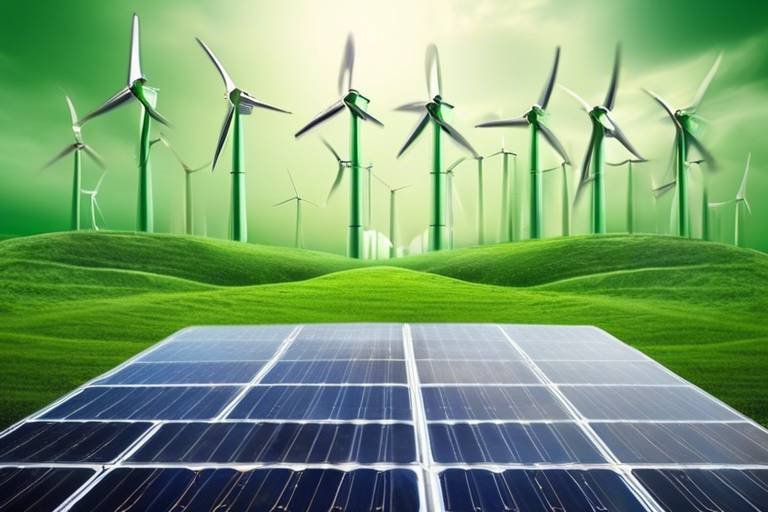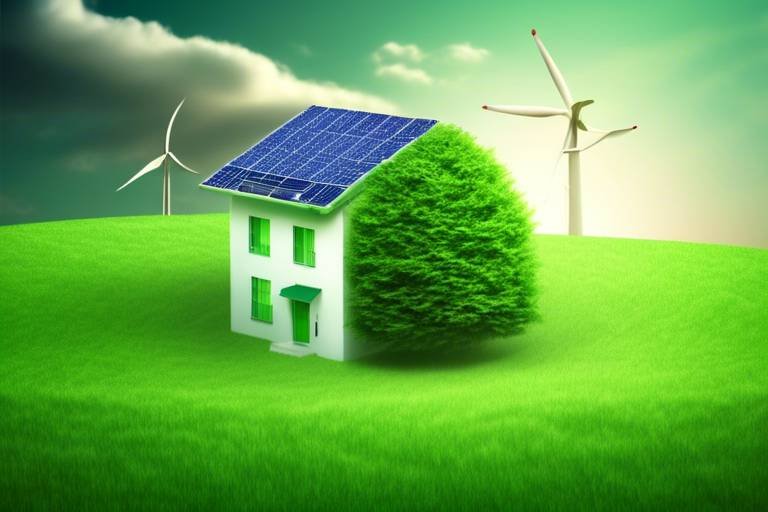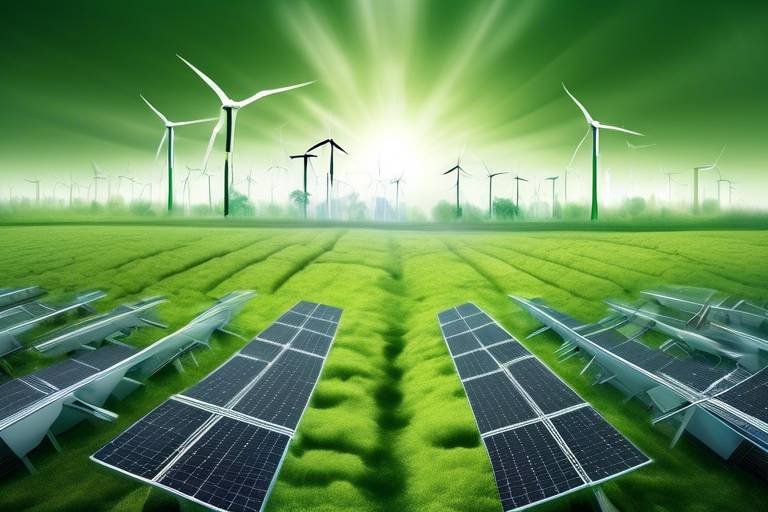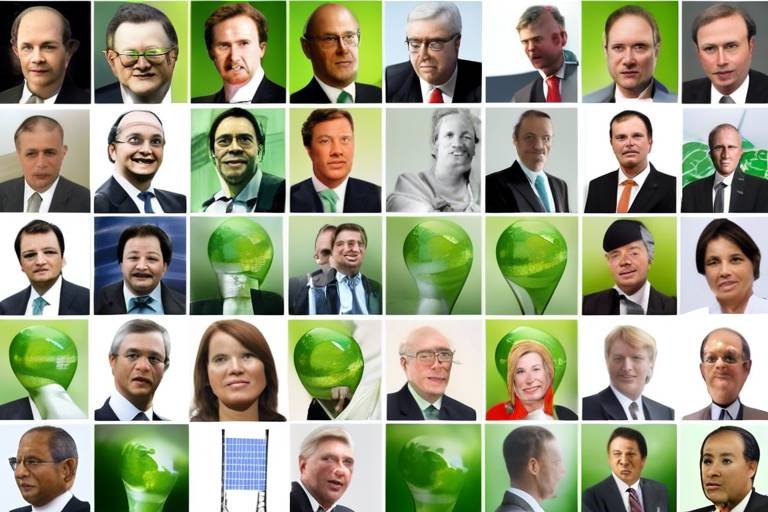Can Green Energy Be the Cornerstone of Sustainable Development?
In today's world, the quest for sustainable development is more crucial than ever. As we grapple with the consequences of climate change, pollution, and dwindling natural resources, the question arises: can green energy truly be the cornerstone of sustainable development? The answer, in short, is a resounding yes! Green energy not only addresses the urgent need to reduce greenhouse gas emissions but also presents a viable path toward a more sustainable future. It’s like finding the missing piece of a jigsaw puzzle that reveals a clearer picture of our planet's health and well-being.
Transitioning from traditional fossil fuels to renewable energy sources is not merely an option; it has become a necessity. The environmental benefits of green energy are profound. By harnessing natural resources such as sunlight, wind, and water, we can significantly lower our carbon footprint and mitigate the effects of climate change. Imagine a world where clean air and water are the norms rather than the exceptions. This vision is achievable through the widespread adoption of green energy technologies.
Moreover, the urgency of this transition cannot be overstated. The Intergovernmental Panel on Climate Change (IPCC) has warned that we must limit global warming to 1.5 degrees Celsius to avoid catastrophic climate impacts. This goal is only attainable through a dramatic reduction in greenhouse gas emissions, which green energy can provide. By investing in renewable energy, we are not just investing in technology; we are investing in our planet's future and the well-being of generations to come.
In addition to environmental sustainability, green energy also offers significant economic benefits. Investing in renewable energy can lead to job creation, technological innovation, and energy independence. It’s an investment that pays dividends not only in environmental health but also in economic stability and growth. Picture a local community thriving on clean energy jobs, where families can find stable employment and contribute to a healthier environment. This is the reality that green energy can help create.
However, the journey toward a sustainable future powered by green energy is not without its challenges. Issues such as high initial costs, technological barriers, and infrastructure limitations must be addressed. Yet, with the right policies, investments, and public support, these challenges can be overcome. It’s a bit like climbing a mountain; the path may be steep and rocky, but the view from the top is worth every effort.
In conclusion, green energy holds the potential to be the cornerstone of sustainable development. It offers a pathway to reduce emissions, stimulate economic growth, and create a healthier planet for future generations. As we stand at this crossroads, the choice is clear: embrace green energy and pave the way for a sustainable future.
- What is green energy? Green energy refers to energy derived from renewable, natural sources that have minimal environmental impact, such as solar, wind, hydro, and geothermal energy.
- How does green energy combat climate change? By replacing fossil fuels with renewable energy sources, green energy reduces greenhouse gas emissions, which are a major contributor to climate change.
- What are the economic benefits of green energy? Green energy can create jobs, stimulate local economies, and reduce energy costs in the long run.
- What challenges does green energy face? Some challenges include high initial investment costs, intermittency of renewable sources, and the need for updated infrastructure.

The Importance of Green Energy
Green energy is not just a buzzword; it's a vital component of our global strategy to combat climate change and ensure a sustainable future. As we continue to witness the devastating effects of climate change—rising sea levels, extreme weather patterns, and biodiversity loss—the urgency to transition from fossil fuels to renewable energy sources has never been greater. This shift is essential for reducing greenhouse gas emissions, which are primarily responsible for global warming.
By embracing green energy, we can significantly lower our carbon footprint and contribute to environmental sustainability. The benefits are multifaceted. For instance, renewable energy sources like solar, wind, and hydroelectric power not only help in reducing emissions but also promote energy independence. Imagine a world where communities generate their own energy, relying less on foreign oil and fossil fuels—this is the potential of green energy.
Moreover, the importance of green energy extends beyond environmental concerns. It plays a crucial role in enhancing public health. Traditional energy sources like coal and oil release harmful pollutants that contribute to respiratory diseases and other health problems. By shifting to cleaner energy sources, we can improve air quality and reduce healthcare costs associated with pollution-related illnesses.
It's also worth noting that green energy can stimulate economic growth. Investing in renewable energy technologies creates jobs, fosters innovation, and drives new industries. According to recent studies, the renewable energy sector is one of the fastest-growing job markets, providing millions of employment opportunities worldwide. This economic potential can be a game-changer for local communities, especially in regions that have relied heavily on fossil fuels.
However, the transition to green energy is not without its challenges. Some may argue that the initial investment costs for renewable energy infrastructure can be high. Yet, when you consider the long-term savings on energy bills and the decreasing costs of technology, the transition becomes not just an environmental imperative but an economic one as well. As we innovate and improve energy efficiency, the financial benefits will only grow.
In summary, the importance of green energy cannot be overstated. It is a cornerstone of sustainable development, offering solutions to environmental, health, and economic challenges. As we navigate the complexities of the energy landscape, embracing green energy is essential for a healthier planet and a more prosperous future.
- What is green energy? Green energy refers to energy derived from renewable, natural sources that have a minimal environmental impact, such as solar, wind, and hydroelectric power.
- How does green energy help combat climate change? By reducing reliance on fossil fuels, green energy lowers greenhouse gas emissions, which are a major contributor to global warming.
- What are the economic benefits of green energy? Investing in green energy creates jobs, stimulates economic growth, and can lead to long-term savings on energy costs.

Types of Green Energy
When it comes to green energy, the options are as diverse as they are exciting. Each type of renewable energy offers unique characteristics and advantages that contribute to a sustainable future. Let's dive into the major types of green energy sources that are paving the way for a cleaner planet.
First up is solar energy. This powerhouse of renewable energy harnesses the sun's rays through photovoltaic cells, converting sunlight into electricity. Imagine capturing the very essence of sunlight and transforming it into power that can light up homes and businesses! Solar energy has witnessed a remarkable surge in adoption, thanks to technological advancements that have made solar panels more efficient and affordable. In fact, the International Energy Agency (IEA) reported that solar energy capacity has increased dramatically over the past decade, and it is projected to continue its upward trajectory.
Next, we have wind energy. This form of energy captures the kinetic energy produced by wind using turbines. Think of wind turbines as giant pinwheels, spinning in the breeze to generate clean electricity. Wind energy has the potential for large-scale energy generation, making it a vital component of a diversified energy mix. Countries like Denmark and Germany have embraced wind energy, showcasing its capability to power entire cities with minimal environmental impact.
Another significant player in the green energy arena is hydropower. By utilizing the flow of water, hydropower plants convert the energy of moving water into electricity. This age-old technology is not only efficient but also reliable, providing a consistent energy supply. However, it’s essential to consider the environmental implications of large dams and ensure that hydropower projects are sustainable and do not disrupt local ecosystems.
Lastly, we have geothermal energy. This lesser-known but equally important source taps into the Earth's internal heat. By harnessing steam or hot water from beneath the Earth's surface, geothermal plants can generate electricity or provide direct heating. It's like having a natural heater right below our feet! Countries like Iceland have successfully utilized geothermal energy, demonstrating its potential to provide a stable and clean energy source.
To summarize, the main types of green energy include:
- Solar Energy: Harnessing sunlight through photovoltaic cells.
- Wind Energy: Capturing kinetic energy from wind using turbines.
- Hydropower: Converting the energy of flowing water into electricity.
- Geothermal Energy: Utilizing the Earth's internal heat for power generation.
As we explore these types of green energy, it becomes clear that each has its unique role to play in our quest for sustainability. By investing in and adopting these renewable sources, we can significantly reduce our reliance on fossil fuels and move towards a cleaner, greener future.
Q: What is green energy?
A: Green energy refers to energy that is generated from natural, renewable sources that have a minimal impact on the environment. Examples include solar, wind, hydro, and geothermal energy.
Q: Why is green energy important?
A: Green energy is crucial for reducing greenhouse gas emissions, combating climate change, and ensuring energy security. It helps create a sustainable future for our planet.
Q: How does solar energy work?
A: Solar energy works by using photovoltaic cells to convert sunlight into electricity. These cells are typically made of silicon and produce electrical current when exposed to sunlight.
Q: What are the challenges of using wind energy?
A: While wind energy is a clean source of power, it can face challenges such as intermittency (not always being available) and the need for significant land space for wind farms.
Q: Can geothermal energy be used anywhere?
A: Geothermal energy is most effective in areas with high geothermal activity, such as tectonic plate boundaries. However, advancements in technology are making it increasingly accessible in more regions.

Solar Energy
Solar energy is one of the most promising and rapidly growing forms of renewable energy. By harnessing the sun’s power through photovoltaic cells, we can transform sunlight into electricity, creating a sustainable source of energy that is both abundant and eco-friendly. As the world grapples with the dire consequences of climate change, the adoption of solar energy has become more crucial than ever. Not only does it provide a clean alternative to fossil fuels, but it also plays a pivotal role in reducing our carbon footprints.
In recent years, we have witnessed a significant uptick in the installation of solar panels across homes, businesses, and even large-scale solar farms. The technological advancements in solar energy systems have made them more efficient and accessible than ever. For instance, the efficiency of photovoltaic cells has improved dramatically, allowing them to convert more sunlight into usable energy. This surge in adoption is not just a trend; it’s a movement towards a more sustainable future, where clean energy can power our lives without harming the planet.
One of the standout features of solar energy is its versatility. It can be used in various applications, from powering residential homes to supplying electricity to entire cities. Moreover, solar energy systems can be installed on rooftops, integrated into building designs, or deployed in solar farms, making it adaptable to different environments. This flexibility is key to its growing popularity.
The benefits of solar energy extend far beyond just reducing greenhouse gas emissions. Here are some of the most significant advantages:
- Low Operating Costs: Once installed, solar panels require minimal maintenance and have very low operating costs compared to traditional energy sources.
- Energy Independence: By generating your own electricity, you reduce reliance on external energy suppliers, which can be especially beneficial during energy crises.
- Job Creation: The solar industry is creating jobs at an unprecedented rate, contributing to local economies and providing employment opportunities.
- Increased Property Value: Homes equipped with solar energy systems often see an increase in property value, making them a smart investment.
These benefits not only empower individuals and communities but also promote economic growth. Imagine a neighborhood where homes are powered by the sun, contributing to a cleaner environment and reducing energy bills. It’s a win-win situation!
Despite its numerous advantages, solar energy is not without its challenges. One of the most significant hurdles is the high initial cost of installation. While prices have dropped significantly over the years, the upfront investment can still be a barrier for many homeowners and businesses. However, various financing options and government incentives are available to help mitigate these costs.
Another challenge is the intermittency of solar energy. Solar panels generate electricity only when the sun is shining, which means that energy production can fluctuate throughout the day and is affected by weather conditions. To address this issue, advancements in battery storage technology are crucial. By storing excess energy generated during sunny periods, we can ensure a reliable power supply even when the sun isn’t shining.
In conclusion, solar energy represents a powerful tool in our quest for sustainable development. With its myriad benefits and ongoing technological advancements, it holds the potential to revolutionize how we produce and consume energy. As we continue to tackle the challenges of climate change, embracing solar energy could very well be the key to a greener, more sustainable future.
- What is solar energy? Solar energy is the energy harnessed from the sun's rays, which can be converted into electricity using photovoltaic cells.
- How do solar panels work? Solar panels absorb sunlight and convert it into electricity through a process called the photovoltaic effect.
- Are solar panels worth the investment? Yes, while the initial investment can be high, the long-term savings on energy bills and potential increases in property value make solar panels a worthwhile investment.
- What are the environmental benefits of solar energy? Solar energy reduces greenhouse gas emissions, decreases reliance on fossil fuels, and contributes to cleaner air and water.

Benefits of Solar Energy
When we think about the future of energy, solar energy shines brightly as a beacon of hope. One of the most compelling benefits of solar energy is its ability to drastically reduce our carbon footprint. By harnessing the power of the sun, we can significantly cut down on greenhouse gas emissions, which is crucial for combating climate change. Imagine a world where we rely on clean, renewable energy instead of fossil fuels—this is not just a dream; it's becoming a reality!
Another remarkable advantage is the low operating costs associated with solar energy systems. Once installed, solar panels require minimal maintenance and can produce energy at a fraction of the cost of traditional energy sources. This means that homeowners and businesses can enjoy substantial savings on their energy bills over time. In fact, studies show that solar energy can save consumers up to 70% on their electricity costs. Isn't that a fantastic incentive to make the switch?
Moreover, solar energy promotes energy independence. By generating your own electricity, you become less reliant on external energy suppliers, which can protect you from fluctuating energy prices and supply shortages. This independence can empower communities, particularly in remote or underserved areas, allowing them to take control of their energy needs. Think of it as a community coming together, like a team, to harness the sun's power and create a sustainable future.
In addition to financial benefits, solar energy also has a positive impact on local economies. The installation of solar panels creates jobs, from manufacturing to installation and maintenance. As more people invest in solar technology, we can expect to see a surge in green jobs that not only support families but also contribute to a healthier planet. It's a win-win situation!
Furthermore, solar energy can help in reducing air pollution. Unlike fossil fuels, which release harmful pollutants into the atmosphere, solar energy is clean and safe. By transitioning to solar power, we can improve air quality, leading to better health outcomes for communities. Imagine breathing in fresh, clean air instead of smog and toxins—this is the kind of world we can create through solar energy.
Lastly, the technology behind solar energy is constantly evolving. Innovations in photovoltaic cells and energy storage solutions are making solar energy more efficient and accessible than ever before. As technology advances, we can expect to see even more benefits emerge, making solar energy a cornerstone of sustainable development.
- What are the long-term savings of using solar energy?
Over time, homeowners can save thousands of dollars on electricity bills, with some estimates suggesting savings of up to 70%.
- How does solar energy impact the environment?
Solar energy significantly reduces greenhouse gas emissions and air pollution, contributing to a cleaner environment.
- What are the upfront costs of installing solar panels?
While the initial investment can be high, various incentives and financing options are available to make solar energy more affordable.

Challenges of Solar Energy
While solar energy is heralded as a beacon of hope in the quest for sustainable energy, it is not without its challenges. One of the primary hurdles is the high initial investment required for solar panel installation. Although prices have dropped significantly over the past decade, the upfront costs can still deter many homeowners and businesses from making the switch. This is particularly true for low-income households who may lack access to financing options or incentives that could alleviate these costs.
Another challenge is the intermittency of solar energy. The sun doesn’t shine 24/7, which means that energy production can be inconsistent, especially during cloudy days or at night. This variability necessitates the development of efficient energy storage solutions, such as batteries, to ensure a reliable supply of electricity. The current technology for energy storage is improving, but it still requires significant investment and innovation to become widely adopted.
Moreover, the space requirement for solar farms can be a limiting factor. Large-scale solar installations need vast areas of land, which can lead to conflicts over land use, particularly in densely populated regions. This raises important questions about how to balance the need for renewable energy with other land uses, such as agriculture or urban development.
Lastly, the environmental impact of solar panel production and disposal cannot be ignored. While solar energy itself is clean, the manufacturing process involves the use of hazardous materials. Additionally, the end-of-life disposal of solar panels poses environmental challenges, as improper disposal can lead to toxic leakage. Therefore, developing sustainable manufacturing and recycling processes is crucial for the long-term viability of solar energy.
In summary, while solar energy is a powerful tool in the fight against climate change, it faces several challenges that must be addressed. Overcoming these obstacles will require collaboration between governments, industries, and communities to create innovative solutions that make solar energy accessible and sustainable for everyone.
- What are the main challenges facing solar energy today?
Solar energy faces challenges such as high initial costs, intermittency, land use conflicts, and environmental impacts from production and disposal. - How can the high costs of solar energy be addressed?
Government incentives, financing options, and technological advancements can help lower the initial costs of solar energy systems. - What is being done to improve energy storage for solar energy?
Research and development in battery technology and other energy storage solutions are ongoing to enhance the reliability of solar energy. - Are there any environmental concerns related to solar panel production?
Yes, the production of solar panels involves hazardous materials, and proper disposal methods are needed to mitigate environmental risks.

Wind Energy
Wind energy is one of the most promising forms of renewable energy, harnessing the natural power of wind to generate electricity. Imagine standing on a hill, feeling the cool breeze on your face while watching giant turbines spin gracefully in the distance. This is not just a picturesque scene; it's a glimpse into a sustainable future powered by wind. As we face the pressing challenge of climate change, wind energy emerges as a vital player in the quest for clean, renewable resources. With advancements in technology and growing public awareness, the potential for wind energy to contribute significantly to our energy needs is more promising than ever.
Wind turbines work by converting the kinetic energy of wind into mechanical energy, which is then transformed into electricity. This process is incredibly efficient, making wind energy one of the most cost-effective forms of renewable energy available today. According to recent studies, wind energy can produce electricity at a lower cost than traditional fossil fuels, which is a win-win for both the environment and consumers.
Moreover, wind energy is incredibly versatile. It can be harnessed onshore, where turbines are installed on land, or offshore, where they are placed in bodies of water. Offshore wind farms have gained traction in recent years due to their ability to capture stronger and more consistent winds, leading to higher energy output. This dual capability allows for a diversified energy mix, reducing reliance on any single source and enhancing energy security.
However, like any energy source, wind energy comes with its own set of challenges. Some of the common concerns include:
- Intermittency: Wind is not always reliable; it doesn't blow consistently, which can lead to fluctuations in energy supply.
- Impact on Wildlife: Turbines can pose risks to birds and bats, leading to ecological concerns.
- Noise Pollution: Some people living near wind farms report issues with noise from turbine blades.
Despite these challenges, the benefits of wind energy far outweigh the drawbacks. It plays a crucial role in reducing greenhouse gas emissions and combating climate change. As countries around the globe commit to ambitious climate goals, wind energy is stepping up to the plate, providing a clean, sustainable alternative to fossil fuels.
In summary, wind energy is not just a fleeting trend; it is a cornerstone of sustainable development. With continued investment in technology and infrastructure, wind energy can help power our homes, businesses, and ultimately, our future. As we embrace this renewable resource, we take significant strides towards a cleaner, greener world.
- What is wind energy? Wind energy is the process of converting wind into electricity using wind turbines.
- How do wind turbines work? Wind turbines capture the kinetic energy of wind and convert it into mechanical energy, which is then transformed into electricity.
- Are there any downsides to wind energy? Yes, challenges include intermittency, impact on wildlife, and noise pollution, but these are being addressed through technology and planning.
- Is wind energy cost-effective? Absolutely! Wind energy has become one of the most affordable energy sources available today.

Economic Impacts of Green Energy
As we venture into the world of green energy, it's essential to recognize its profound economic impacts. Transitioning to renewable energy sources isn’t just about saving the planet; it’s also about revitalizing our economies. Imagine a world where clean energy not only powers our homes but also fuels job growth and innovation. This shift can create a vibrant economic landscape, paving the way for a sustainable future.
Investing in green energy can stimulate job creation and economic growth in several ways. For starters, the renewable energy sector is burgeoning, with millions of jobs already created globally. These jobs span a wide range of fields, from engineering and manufacturing to installation and maintenance. In fact, according to recent studies, the renewable energy sector is projected to grow significantly in the coming years, potentially outpacing traditional fossil fuel industries. This growth is not just a passing trend; it represents a fundamental shift in how we think about energy and employment.
Moreover, the economic benefits of green energy extend beyond job creation. By investing in renewable technologies, communities can experience lower energy costs in the long run. As the technology advances and economies of scale kick in, the cost of generating energy from sources like solar and wind continues to decline. This means that businesses and consumers alike can save money on their energy bills, allowing them to invest in other areas of their lives, such as education, healthcare, or local businesses.
To illustrate this point further, let’s take a look at a simple comparison of the costs associated with fossil fuels versus green energy over time:
| Energy Source | Initial Investment | Long-Term Costs | Environmental Impact |
|---|---|---|---|
| Fossil Fuels | High | Increasing over time | High emissions |
| Solar Energy | Moderate | Decreasing over time | Low emissions |
| Wind Energy | Moderate | Decreasing over time | Low emissions |
This table highlights the stark differences in economic sustainability between traditional fossil fuels and renewable energy sources. While fossil fuels may have lower initial costs, the long-term implications often result in higher expenses due to fluctuating prices and environmental penalties. On the other hand, green energy sources not only promise lower long-term costs but also contribute to a healthier planet.
Furthermore, the transition to green energy is also a matter of energy security. By investing in local renewable sources, countries can reduce their dependence on imported fuels, which often come with volatile prices and geopolitical risks. This shift not only enhances national security but also keeps energy dollars circulating within local economies, further boosting job creation and economic resilience.
In summary, the economic impacts of green energy are multifaceted and profound. From job creation to cost savings and energy security, the benefits are clear. As we move forward, embracing renewable energy sources will not only help combat climate change but also lay the groundwork for a more robust and sustainable economy.
- What are the main benefits of green energy?
Green energy reduces greenhouse gas emissions, creates jobs, and can lead to lower energy costs in the long run. - How does green energy contribute to economic growth?
By creating jobs in various sectors and reducing energy costs, green energy investments stimulate local economies. - Are there any challenges associated with green energy?
Yes, challenges include high initial costs and intermittency, but advancements in technology are addressing these issues.

Job Creation in Renewable Energy
As we dive into the world of renewable energy, one of the most exciting aspects is the **explosion of job opportunities** it presents. The transition from fossil fuels to greener alternatives is not just an environmental necessity; it’s also a **goldmine for job seekers**. In fact, the renewable energy sector is rapidly evolving, creating millions of jobs worldwide. This growth is driven by several factors, including technological advancements, increased investment, and the urgent need to combat climate change.
To put things into perspective, let’s consider some key statistics. According to recent reports, the renewable energy industry has seen a staggering increase in employment rates. For instance, in 2020 alone, the solar and wind sectors combined accounted for over **500,000 new jobs** in the United States. This surge is a clear indicator that investing in green energy is not just a trend; it's a **sustainable path forward** for job creation.
But what types of jobs are being generated in the renewable energy sector? The roles vary widely, ranging from highly skilled positions such as engineers and project managers to more hands-on jobs like technicians and installers. Here’s a brief overview of some of the job categories:
- Engineering and Design: Professionals in this field focus on creating innovative solutions to harness renewable energy effectively.
- Installation and Maintenance: Technicians are essential for setting up and maintaining solar panels, wind turbines, and other renewable systems.
- Research and Development: Scientists and researchers are constantly working on improving technology and efficiency in renewable energy sources.
- Policy and Advocacy: Experts in this area help shape laws and regulations that promote the growth of renewable energy.
Moreover, the economic ripple effect of job creation in renewable energy is profound. As these jobs emerge, they stimulate local economies, leading to increased spending in communities. This growth not only supports families but also strengthens local businesses, creating a **vibrant ecosystem** where everyone benefits.
Additionally, the renewable energy sector is known for its diversity in job creation. It offers opportunities for individuals from various backgrounds and skill sets, promoting inclusivity within the workforce. This is particularly important as we strive for a future that embraces **equal opportunities for all**. The renewable energy industry actively seeks to engage underrepresented communities, ensuring that everyone has a chance to contribute to this green revolution.
In conclusion, the job creation potential in renewable energy is not just a fleeting moment; it represents a significant shift towards a sustainable future. As we continue to invest in these technologies, we are not only addressing climate change but also paving the way for a robust job market that can support generations to come.
Q1: What types of jobs are available in the renewable energy sector?
A1: The renewable energy sector offers a wide range of jobs, including engineering, installation, maintenance, research, and policy advocacy roles.
Q2: How many jobs has the renewable energy sector created?
A2: The renewable energy sector has created millions of jobs worldwide, with significant growth observed in solar and wind industries.
Q3: Are jobs in renewable energy well-paying?
A3: Yes, many jobs in the renewable energy sector offer competitive salaries, often higher than traditional fossil fuel jobs, especially in engineering and technical roles.
Q4: How can I get involved in the renewable energy job market?
A4: You can get involved by pursuing education or training in relevant fields, seeking internships, and networking with professionals in the industry.

Cost Comparisons with Fossil Fuels
The conversation around energy costs is heating up—much like the planet itself! As we dive into the world of renewable energy, one of the most compelling arguments for green energy is its cost-effectiveness compared to fossil fuels. Historically, fossil fuels have dominated our energy landscape, but the tides are turning. With advances in technology and growing awareness of environmental issues, the financial implications of choosing renewable sources are becoming increasingly favorable.
First off, let’s consider the initial investment. Traditional fossil fuel energy sources often come with hidden costs, including environmental degradation and health issues that can result from pollution. In contrast, while the upfront costs of solar panels or wind turbines can be significant, they are often offset by long-term savings. According to recent studies, the cost of solar energy has dropped by over 80% since 2010, making it one of the most affordable energy sources available today.
Moreover, as technology evolves, the operational costs associated with renewable energy continue to decline. For example, wind and solar farms require minimal maintenance once they are up and running. In fact, a recent report indicated that the levelized cost of electricity (LCOE) for solar and wind is now cheaper than coal and natural gas in many regions. This is a game changer! To illustrate, here’s a quick comparison of the LCOE for different energy sources:
| Energy Source | Levelized Cost of Electricity (LCOE) per MWh |
|---|---|
| Solar Energy | $30 - $60 |
| Wind Energy | $30 - $50 |
| Natural Gas | $40 - $70 |
| Coal | $60 - $120 |
As the table shows, both solar and wind energy not only compete but often outperform fossil fuels in terms of cost. This trend is likely to continue as more investments pour into renewable technologies, driving prices down further. But it’s not just about the numbers; it’s about the value these energy sources bring to the table. By investing in green energy, consumers and businesses alike can enjoy stable energy costs that are less susceptible to market fluctuations and geopolitical tensions that often affect fossil fuel prices.
Another aspect to consider is the incentives and tax breaks available for renewable energy installations. Many governments offer financial incentives to encourage the adoption of green technologies, which can significantly reduce the overall cost. These incentives can make a substantial difference in the decision-making process for both homeowners and businesses. When you factor in these subsidies, the cost of transitioning to renewable energy becomes even more attractive.
In conclusion, the cost comparisons between green energy and fossil fuels reveal a promising shift towards a more sustainable and economically viable future. As we continue to innovate and invest in renewable technologies, the gap will only widen, making green energy not just an environmentally responsible choice, but also a financially savvy one. So, are you ready to join the green revolution and embrace a cleaner, more sustainable energy future?
- What are the main advantages of switching to green energy? Green energy reduces greenhouse gas emissions, offers long-term cost savings, and promotes energy independence.
- Are there any financial incentives for adopting renewable energy? Yes, many governments offer tax credits, rebates, and other incentives to encourage the installation of renewable energy systems.
- How does the cost of solar energy compare to fossil fuels? Solar energy has become significantly cheaper than fossil fuels, with costs dropping over 80% in the last decade.
- What challenges does the renewable energy sector face? Challenges include high initial investment costs, intermittency issues, and the need for better energy storage solutions.
Frequently Asked Questions
- What is green energy?
Green energy refers to energy derived from natural sources that are replenished constantly, such as solar, wind, hydro, and geothermal. Unlike fossil fuels, green energy produces little to no greenhouse gas emissions, making it a key player in the fight against climate change.
- Why is green energy important for sustainable development?
Green energy is essential for sustainable development as it helps reduce our reliance on fossil fuels, lowers greenhouse gas emissions, and promotes environmental health. By transitioning to renewable energy sources, we can ensure a cleaner, healthier planet for future generations.
- What are the different types of green energy?
There are several types of green energy, including:
- Solar Energy: Harnessing sunlight through solar panels.
- Wind Energy: Capturing wind power using turbines.
- Hydro Energy: Generating electricity from flowing water.
- Geothermal Energy: Utilizing heat from the Earth’s core.
- What are the benefits of solar energy?
Solar energy offers numerous advantages, such as:
- Lower operating costs over time.
- Energy independence for communities.
- Reduction in carbon footprints.
- What challenges does solar energy face?
Despite its many benefits, solar energy encounters challenges like:
- High initial installation costs.
- Intermittency, as it relies on sunlight.
- Space requirements for solar farms.
- How does wind energy contribute to sustainable development?
Wind energy plays a significant role in sustainable development by providing a clean and renewable source of electricity. It helps diversify the energy mix, reduces dependence on fossil fuels, and can generate substantial economic benefits through job creation and local investments.
- What economic impacts does investing in green energy have?
Investing in green energy can stimulate job creation, promote economic growth, and lead to substantial long-term savings for consumers and businesses. As technology advances, the costs of renewable energy sources continue to decrease, making them more accessible and economically viable.
- How does the cost of green energy compare to fossil fuels?
As technology improves and scales up, the cost of green energy is dropping significantly. In many cases, renewable energy sources are now cheaper than fossil fuels, leading to potential savings for both consumers and businesses over time.



















